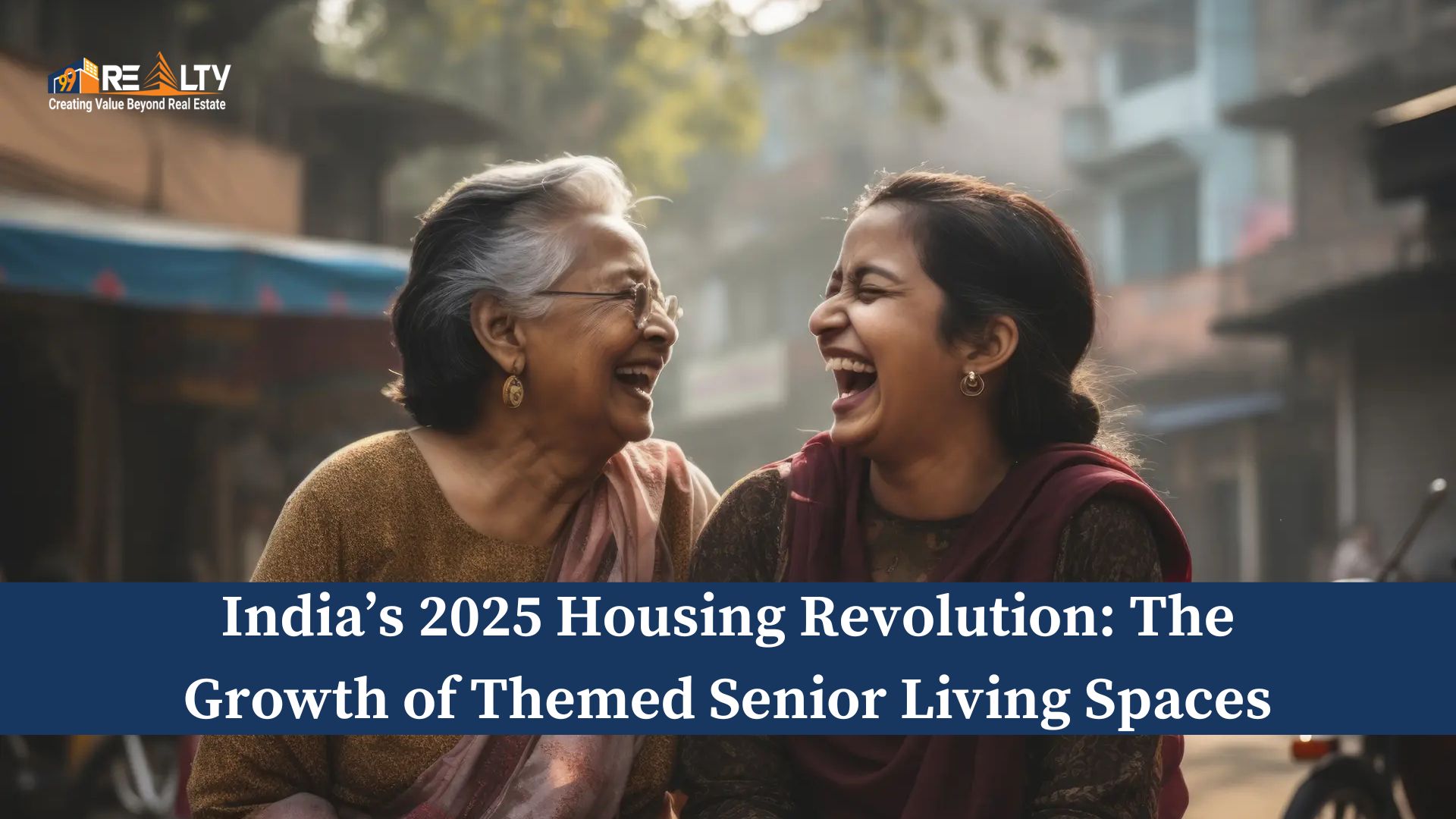For decades, home ownership in India revolved around one dream, a place for the entire family. But as India’s demographics evolve and lifestyles change, the definition of “home” is being reimagined. The rise of themed living spaces, homes designed for specific life stages or lifestyle preferences is reshaping the residential landscape.
Among the most promising of these emerging categories is senior living, homes tailored for the 55+ age group that combine comfort, security, healthcare, and community engagement.
In 2025, senior living projects are no longer a niche segment. They are becoming a mainstream, aspirational lifestyle choice, backed by strong investor interest and growing social acceptance.

What are themed living spaces?
Themed living refers to residential communities designed around a specific concept or demographic need such as co-living, student housing, wellness homes, eco-friendly residences, or senior living.
Instead of being “one size fits all,” these projects offer curated environments that focus on a shared lifestyle theme, whether it’s sustainability, age-friendly amenities, or community-based wellness.
How is it evolving?
In India, themed living has evolved as a response to the changing needs of its diverse population:
• Young professionals prefer co-living near employment hubs.
• Students seek managed accommodation with flexibility and safety.
• Families opt for gated communities with lifestyle amenities.
• Seniors look for comfort, care, and companionship, all under one roof.
Among these, senior living has emerged as one of the most structured and rapidly growing categories in 2025.
Real stories: From dependence to empowerment
Across India, residents of senior communities are living examples of this transformation.
• At Ashiana Shubham (Chennai), residents often describe the community as “a second innings home”, a place where they rediscover hobbies, friendships, and a healthier routine.
• At Paranjape Athashri (Pune), retirees run their own cultural clubs, fitness groups, and learning circles.
Why senior living is gaining ground in India?
India’s aging population: The numbers speak
India is aging faster than many realize. According to the National Statistical Office (NSO):
• India’s senior citizen population (60+) will reach ~194 million by 2031, up from 138 million in 2021.
• Seniors will make up ~14% of India’s population by 2041.
This demographic shift is fueling a structural need for senior-friendly housing, especially in urban and semi-urban markets.
Changing family structures
The rise of nuclear families and migration for work means more elderly people are choosing independent, community-based living rather than staying alone or depending solely on family. Today’s seniors are active, tech-savvy, and financially independent. They want autonomy with convenience, a life that blends freedom, healthcare, and social connection.
The emotional and lifestyle shift
Earlier, senior housing was seen as a form of assisted care or “retirement home.”
Now, it represents dignified, aspirational living, much like premium gated communities but tailored for the 55+ segment.
How senior living projects are designed: Thematic and thoughtful
A senior living community is not just a cluster of apartments. It is an ecosystem designed around comfort, safety, and wellness. Here’s what defines the architecture of these spaces:
senior living financial security
Features
• Barrier-free design: Step-free entries, ramps, wider doorways for easy movement
• Medical support: On-call doctors, tie-ups with hospitals, 24×7 emergency response
• Community engagement: Activity centers, hobby rooms, fitness clubs, and festivals
• Security & maintenance: Gated access, trained staff, reliable maintenance
• Green spaces: Parks, walking tracks, and natural surroundings for relaxation
Market growth: From niche to opportunity
The senior living housing market in India is estimated to cross ₹50,000 crore by 2030, growing at a CAGR of over 20%. In 2025, approximately 20,000+ operational senior living units exist across India, with several thousand more in the pipeline.
Market size in 2025
The senior living housing market in India is estimated to cross ₹50,000 crore by 2030, growing at a CAGR of over 20%. In 2025, approximately 20,000+ operational senior living units exist across India, with several thousand more in the pipeline.
Investor interest
Institutional investors are warming up to the category because of:
• Stable occupancy rates (80 to 90% in mature projects)
• Low churn due to long-term stays
• Predictable maintenance income streams
REITs and real-estate funds are also beginning to eye senior living as an alternative asset class, much like student housing and co-living in earlier years.
Is senior living an investment opportunity?
For Developers
Themed senior living projects have higher per-square-foot realization than standard residential ones due to:
• Premium amenities
• Low inventory competition
• Faster absorption in target markets
Additionally, senior homes ensure steady maintenance revenue due to service-based living models
For homebuyers and investors
For buyers, senior living homes serve dual benefits:
• As end-users: Freedom, companionship, and healthcare.
• As investors: Long-term rental demand and value appreciation.
A 2BHK senior living unit priced around ₹75 lakh in Chennai today could appreciate 8 to 10% annually, given the limited supply and growing demand in 2025-26.
The social impact: Reimagining retirement in India
The conversation around retirement living is shifting from “dependence” to “choice.”
Themed living beyond senior housing: India’s lifestyle revolution
Senior living communities often organize:
• Yoga and wellness workshops
• Hobby clubs and music sessions
• Volunteering programs
• Health check camps and nutritional plans
These create a sense of belonging and purpose, addressing one of the biggest modern concerns, loneliness among seniors.
Lifestyle-based housing
Senior living is part of a broader shift towards lifestyle-based housing.
Other growing segments include:
• Wellness homes: Integrating air filtration, organic gardens, and mental wellness zones
• Eco-conscious homes: Built around sustainability and energy efficiency.
• Pet-friendly apartments: Providing pet parks, grooming stations, and veterinary tie-ups.
• Women-only housing: Secure co-living for working women in metros.
• Smart senior homes: integrating AI-based health monitoring and IoT devices.
As technology blends with real estate, 2025 and beyond will see homes designed around emotions, not just structures.
The Road Ahead: 2025-30 Outlook
Government and policy push
The Indian government has started acknowledging senior living as a formal housing category.
Key enablers:
• Model Guidelines for Senior Care Homes (2021) by the Ministry of Social Justice & Empowerment.
• Incentives for developers under “Senior Citizen Housing” schemes in some states.
• Favorable FDI norms encouraging global operators to collaborate with Indian builders.
These policies are likely to encourage public-private partnerships (PPP) for integrated senior communities in Tier-1 and Tier-2 cities.
Demand evolution
• Demand will double by 2030, especially in South India.
• Expect the entry of global brands offering luxury retirement living formats.
Technology integration
• Smart monitoring systems for health and home automation will become standard.
• Digital concierge apps for grocery, healthcare, and social events will enhance convenience.
Wellness and healthcare partnerships
• Tie-ups with hospitals and wellness brands (like Apollo, Fortis, Medanta) will be a major differentiator.
• Expect on-site diagnostic centers and telemedicine kiosks within communities.
Pricing trends
• 2025 average price range: ₹60 lakh to ₹1.6 crore (2BHK / 3BHK).
• Affordable senior living (below ₹50 lakh) will emerge in Tier-2 cities like Coimbatore, Mysuru, and Indore.
Challenges ahead
Despite the momentum, some challenges persist:
• Limited financing options; banks still treat senior housing as a niche.
• Misconceptions about “old-age homes.”
• Lack of skilled operators for large-scale community management.
• Need for standardized policies and tax incentives.
However, these are transitional/teething challenges, as awareness and demand rise, the segment is expected to mature rapidly.
The year 2025 marks a defining moment in India’s real estate evolution.
Senior living is no longer a niche concept—it’s rapidly emerging as a mainstream residential segment that reflects how Indians aspire to age with dignity, comfort, and independence. With a steadily aging population, rising awareness, and supportive government policies, senior living communities are poised to become the next big chapter in India’s housing landscape.
Over the next five years, we can expect a surge in integrated townships that feature dedicated senior zones, wellness clusters, and multi-generational living spaces—signaling a shift toward inclusive housing that embraces every stage of life.
Need Help?
Need help evaluating a property or planning your next move in the market?
Reach out to 99 REALTY – your trusted real estate partner for smarter choices.
Subscribe to get updates on our latest posts and market trends.






Join The Discussion